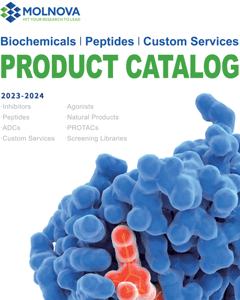
Conopressin S
CAS No. 111317-90-9
Conopressin S( Con-S )
Catalog No. M29891 CAS No. 111317-90-9
Conopressin S, isolated from Conus striatus, shows high affinity with vasopressin V1b receptor (AVPR1B), with a Ki of 8.3 nM.
Purity : >98% (HPLC)
 COA
COA
 Datasheet
Datasheet
 HNMR
HNMR
 HPLC
HPLC
 MSDS
MSDS
 Handing Instructions
Handing Instructions
| Size | Price / USD | Stock | Quantity |
| 100MG | Get Quote | Get Quote |


|
| 200MG | Get Quote | Get Quote |


|
| 500MG | Get Quote | Get Quote |


|
Biological Information
-
Product NameConopressin S
-
NoteResearch use only, not for human use.
-
Brief DescriptionConopressin S, isolated from Conus striatus, shows high affinity with vasopressin V1b receptor (AVPR1B), with a Ki of 8.3 nM.
-
DescriptionConopressin S, isolated from Conus striatus, shows high affinity with vasopressin V1b receptor (AVPR1B), with a Ki of 8.3 nM.
-
In Vitro——
-
In Vivo——
-
SynonymsCon-S
-
PathwayOthers
-
TargetOther Targets
-
RecptorKi: 8.3 nM (AVPR1B)
-
Research Area——
-
Indication——
Chemical Information
-
CAS Number111317-90-9
-
Formula Weight1028.26
-
Molecular FormulaC41H73N17O10S2
-
Purity>98% (HPLC)
-
Solubility——
-
SMILES——
-
Chemical NameSequence:{Cys}{Ile}{Ile}{Arg}{Asn}{Cys}{Pro}{Arg}{Gly}-NH2(Disulfide bridge: Cys1-Cys6)
Shipping & Storage Information
-
Storage(-20℃)
-
ShippingWith Ice Pack
-
Stability≥ 2 years
Reference
Dutertre S, et al. Conopressin-T from Conus tulipa reveals an antagonist switch in vasopressin-like peptides. J Biol Chem. 2008 Mar 14;283(11):7100-8.
molnova catalog



related products
-
EL-102
EL-102 is a HIF1α inhibitor with anticancer activity that inhibits microtubule protein polymerization and can be used to study prostate cancer.
-
Cajanine
Cajaninstilbene acid is a useful organic compound for research related to life sciences.
-
PRGL493
PRGL493 is an inhibitor of long-chain acyl-CoA synthetase 4 (ACSL4).1It inhibits formation of arachidonoyl-CoA (AA-CoA) from arachidonic acid in, as well as the proliferation and migration of, PC3 and MDA-MB-231 cancer cells when used at a concentration of 50 μM.



 Cart
Cart
 sales@molnova.com
sales@molnova.com


